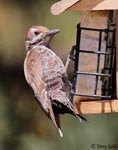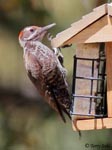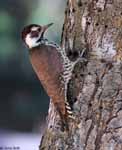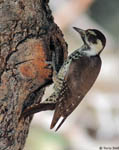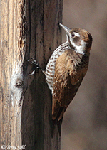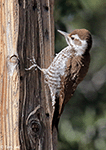| Length: 7.5 inches | Wingspan: 14 inches | Seasonality: Non-resident in South Dakota |
| ID Keys: Dark brownish back, spotted breast and barred belly, large white patch on back of neck | ||
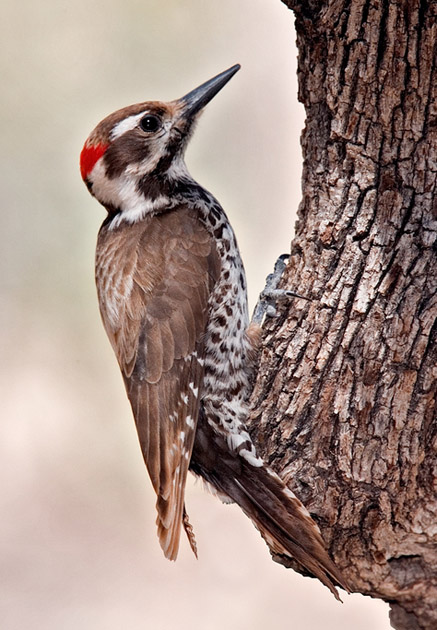 The
Arizona Woodpecker was once considered conspecific with the Strickland's
Woodpecker, but they are now considered separate species by most
authorities. They are primarily a bird of Mexico, with a range that
just crosses into the United States in extreme southern Arizona and New
Mexico. As with many Dryobates woodpeckers, males and females are very
similar in appearance, except the male has a red patch on the back of his
head. While at first glance they may appear to be similar in shape and
structure to other North American woodpeckers species, they are the only
North American woodpecker with a solid brown back.
The
Arizona Woodpecker was once considered conspecific with the Strickland's
Woodpecker, but they are now considered separate species by most
authorities. They are primarily a bird of Mexico, with a range that
just crosses into the United States in extreme southern Arizona and New
Mexico. As with many Dryobates woodpeckers, males and females are very
similar in appearance, except the male has a red patch on the back of his
head. While at first glance they may appear to be similar in shape and
structure to other North American woodpeckers species, they are the only
North American woodpecker with a solid brown back.
Habitat:
In the United States portion of its range, the Arizona Woodpecker is found in lower to mid-elevation oaks and oak-pine woodlands. They tend to be found at higher elevations further south in the Mexican part of their range, in pine forests.
Diet:
Feeds mostly on insects, especially on the larvae of wood-boring beetles. Also feeds on fruits and berries, and occasionally nuts and acorns. They have also been seen feeding on the nectar of certain flowers such as agaves.
Behavior:
Forages by climbing on the trunks and branches of trees, probing for insects and flaking off bits of bark to access wood-boring beetles and their larvae. When foraging, they often start at the base of a tree, work their way up, and then fly down towards the base of another tree to start again.
Nesting:
The nest of an Arizona Woodpecker is a cavity in a dead portion of a tree, or sometimes in other cavities such as in the stalk of a large agave. The male likely does most of the excavation of the nest hole. Three or four eggs are laid, and both parents help to incubate them. After hatching, both parents help to feed the young.
Interactive eBird map:
Click to access an interactive eBird map of Arizona Woodpecker sightings
Song:
Has a harsh rattling call that descends in pitch. The common call is a squeaky peek.
Migration:
Considered a permanent resident throughout their range. The only movements are minor elevational movements in response to season, with some birds moving short distances to lower elevations in winter.
Similar Species:
Distinctive plumage if seen well. Arizona Woodpeckers are the only woodpecker in the United States with a solid brown back. Similar in structure and behavior to the Hairy Woodpecker.
Feeders:
Will attend feeders for suet, fruit, and nuts
Conservation Status:
Populations of the Arizona Woodpecker are stable or perhaps even increasing, and the IUCN lists them as a species of "Least Concern".
Further Information:
- WhatBird - Arizona Woodpecker
- New Mexico Partners in Flight - Arizona Woodpecker
- Audubon Guide - Arizona Woodpecker
Photo Information:
Photo from NaturePicsOnline.com - Licensed under Creative Commons Attribution ShareAlike 3.0 Unported License.
| Click below for a higher-resolution map |
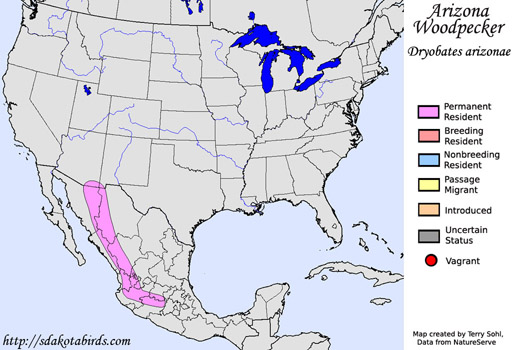 |
| South Dakota Status: Non-resident in South Dakota |
Additional Arizona Woodpecker Photos
Click for a higher-resolution version of these photos
